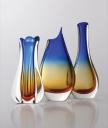Murano, art in colour
 Since ancient times, glass has been revered for the mystical, supernatural aura produced by the magical interplay of light as it hits the transparent material and turns crystal to liquid. Not surprisingly, magicians told the future with it, chemists and alchemists studied it and beautiful women desired it. Equally mesmerised by this versatile material, jewellers and artists started working with glass too, creating works of art that evoke every bit as much emotion and awe as gold and jewels.
Since ancient times, glass has been revered for the mystical, supernatural aura produced by the magical interplay of light as it hits the transparent material and turns crystal to liquid. Not surprisingly, magicians told the future with it, chemists and alchemists studied it and beautiful women desired it. Equally mesmerised by this versatile material, jewellers and artists started working with glass too, creating works of art that evoke every bit as much emotion and awe as gold and jewels.
In the world of glass art, Murano is a byword for Italian design and creativity, synonymous with rich, enchanting colours, spun creations that appear to be made of sugar and bold fluid lines that emphasise the profoundness of the material’s transparency. Visit the small island just off Venice, where Murano creations are produced, and little appears to have changed in its 1,000 year history of glass making. Technology, for one, seems not to have made as great an impact as one would expect, due to the strong emphasis on tradition and the creative skill of the master craftsman. These battono, or glass masters, use essentially the same glowing furnaces, glass blowing pipes and techniques that have been handed down for centuries.
To say that nothing has changed on the island is deceiving, though, as Murano’s history is as varied as it is long. Glass making goes back thousands of years here, partly due to trading links with the Eastern countries such as the Phoenicians, Assyrians and Egyptians, who had a longstanding tradition in glass production. By the twelfth century, a thriving glass industry was established in Venice, but it was when the decision was made in 1292 to move this potential fire hazard to the nearby island of Murano that it really took off. With its plentiful access to sand and other raw materials, master glassblowers started flocking here, and by the end of the 13th century the Grand Council of Venice decreed that master craftsmen were forbidden to leave Murano for fear of taking their secrets with them.
Glass production had become so important that Venice wanted to protect it at all cost, yet as an encouragement to stay, craftsmen were granted special privileges, such as the right to marry their daughters into Venetian nobility, the wearing of swords, and being allowed to participate in the magnificent Venetian carnivals. Soon every royal household and rich aristocratic or merchant family across Europe had to own a unique Murano creation—including Henry VIII of England. During the 15th and 16th centuries, African trade beads formed another lucrative product line. Traded with African tribes for gold, ivory and even slaves, they were highly sought after by Africans and American Indians alike.
The Venetians maintained their monopoly well into the 19th century, when the balance of power in Italy shifted first to Napoleon and the French, and then to the Austrian empire, which imposed heavy taxes on the glass industry in order to protect its own Bohemian factories in Czechoslovakia and Germany. Trade dropped dramatically until a local lawyer called Antonio Salviati turned things around by recognising a hole in the market. He signed-up master technician, Lorenzo Radi, and started work on mosaic tesserae, examples of which can be seen in the cupola of St. Paul’s Cathedral and a portrait of Prince Albert donated to the Victoria and Albert Museum. He then collected together as many antique pieces he could lay his hands on and set up a museum where young apprentice glassmakers were taught techniques that had almost disappeared.
After mastering the art of reproduction, the artisans were encouraged to invent new techniques such as zanfirico or filigree, with twists and spirals of glass and interweaving strings or fragments of different coloured glass that were then melted together. They also developed such techniques as crystalline glass, enamelled glass (smalto), glass with threads of gold (aventurine), multicoloured glass (millefiori), milk glass (lattimo) and started to produce imitation gemstones made of glass. Other groups of glass blowers started to join Salviati and gradually the island once again became a colony of glass blowing families, many of which remain today. Before long, Murano glass became an essential item for hordes of young gentlemen returning with gifts from their Grand Tour.
 Murano today
Murano today
Venetian glass is world renowned for its quality and form, with Murano a name synonymous with production of the finest and most elegant glass pieces, including beads, mirrors, lead windows and glass flowers, as well as iconic products such as vases and drinking glasses. Their creations are among the most recognisable glass products and the Murano School remains one of the most important in the world. Indeed, the bead and glassmaking industry is alive and thriving in Murano, made using the wound lamp-work (torch and mandrel) or drawn (pulled cane) methods. In the case of the former, each bead is made individually using a torch for heat, while a glass cane (also produced in Murano) is heated to a molten state and wrapped around a metal rod until the desired shape is formed. Several layers of glass in varying colours, as well as gold and silver leaf, may be used to produce the desired effect. The bead is then cooled very slowly and removed from the rod, thus producing a hole for eventual threading. The most recognisable styles of Venetian beads are the multi-layered ‘chevron’, the ‘wedding cake’ design with its frosting-like decoration, the multicoloured millifiore and the Venetian foils, characterised by their vibrant colours and decorative use of gold and silver foil.
Throughout the history of art, hollow blown Murano glass has always forged its own path, its strength being its variation of type and class; from poly-chromatic glazes and the gold in the cobalt blue of the Barovier cup to the lightness and transparency of Murano glasses, the delicateness of lattice-work and the originality of its designs and use of colour, Murano has always stood out for its quality and creativity. In recent years, some have called the collections of beads and souvenir items commercial and kitsch, yet Murano remains an exporter of traditional products such as mirrors, quality glassware and glass art, and its furnaces also produce modern items such as door handles, glass lampshades and chandeliers, all of which are highly prized by architects.
The continued popularity of Murano, though, lies in a product range wide enough to touch almost everyone. Some pieces are amusing: coloured fish in transparent glass aquariums, or wrapped boiled sweets of multicoloured glass. Others, such as glass jewellery, are pretty, but while they turn their attention to the frivolous from time to time, Murano’s artisans have never stopped producing stunning works of contemporary art from glass. Visit a glassworks such as Linea Valentina and you’ll find pieces that are technically fascinating.
Although very much on the tourist map, a trip to Murano is well worth the effort. Take a waterbus from Venice and allow yourself to enter an ancient world of glass, where glassblowers offer free demonstrations and precious works from as early as Egyptian times are on display at the Museo Vetrario in the Palazzo Giustinian at the centre of the island. Don’t forget to visit the Church of Santa María e San Donato, deceptively simple on the outside but with a richly decorated interior and marble and mosaic floor laid in 1140, it will be a fitting way to end a ‘glass pilgrimage’. After all, there are other materials and other master craftsmen of glass, but what other tradesman can display a sign saying ‘Supplying quality glass products since 1291’.
By Michel Cruz












